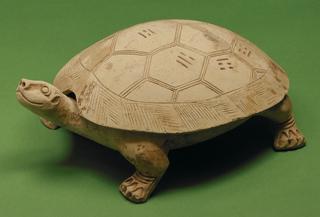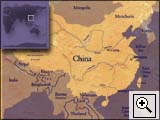
 |
The tortoise-shaped inkstone is a ceramic sculpture made in China during the Han dynasty (206 B.C.-A.D. 220). The Han dynasty was an era of peace, prosperity, and stability. Han leaders expanded the Chinese empire and established a well-organized bureaucratic system that lasted for two thousand years. Their control of most of central Asia led to the opening of the Silk Road, a five-thousand-mile network of caravan and sea routes reaching all the way from China to Imperial Rome.
Most surviving Han ceramic sculptures were made for burial in the tombs
of people at all social and economic levels. This inkstone is a rare discovery;
very few tortoise figures have been found. Most tomb objects were jars
and lamps of many shapes, figures of men and women, animals, houses, and
animal pens.
Han tombs were furnished with ming ch'i, goods to accompany the dead in
the afterlife. These tomb goods indicated the life and social position
of the deceased and provided familiar objects and comforts. The inkstone
identifies the tomb inhabitant as a Chinese scholar, who would have used
it as one of his writing tools.

Key ideas.
Where does it come from?
What does it look like?
How was it used?
How was it made?
How big is it?
Who Knows?
Additional resources.

